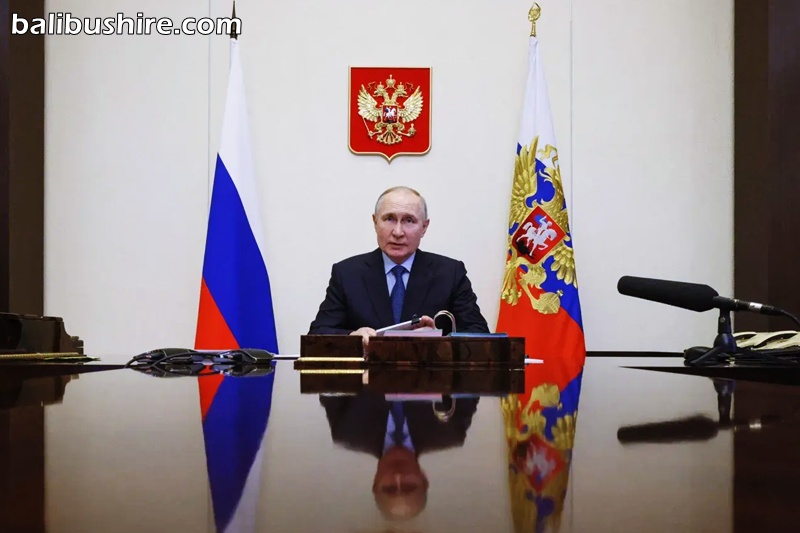Thursday | 23rd October 2025
Moscow, Russia — Russia’s strategic nuclear forces conducted a sweeping readiness test on Wednesday under the direct supervision of President Vladimir Putin, in what the Kremlin described as a “planned exercise” aimed at verifying the country’s command-and-control systems and operational preparedness across its entire nuclear triad.
“Today, we are conducting a planned — I want to emphasize, planned — nuclear forces command and control exercise,” Putin said in a video conference with senior defense officials, underscoring that the drills were routine and not a response to any specific international event.
According to the Russian Ministry of Defense, the exercise involved all three legs of the nation’s nuclear triad — land-based intercontinental ballistic missiles (ICBMs), submarine-launched ballistic missiles (SLBMs), and strategic bombers. The ministry said the purpose of the drill was to simulate a massive retaliatory nuclear strike in the event of an attack on Russia.
Footage broadcast by Zvezda TV, the Russian military’s official television network, showed the launch of a Yars ICBM from the Plesetsk Cosmodrome in northern Russia, as well as a Sineva ballistic missile launched from the Bryansk, a nuclear-powered submarine patrolling the Barents Sea. The footage also showed Tu-95MS “Bear” bombers taking off from airbases and firing long-range air-launched cruise missiles at designated targets.
The Kremlin said the exercise successfully tested the readiness of Russia’s nuclear command systems and the coordination among various branches of its strategic forces, confirming that “all tasks were completed in full.”
Russia regularly holds such nuclear readiness drills as part of its strategic deterrence posture. During a similar exercise last year, Putin declared that the country’s nuclear arsenal “enables us to achieve strategic deterrence objectives and uphold nuclear parity and the global balance of power.”
The latest exercise comes at a time of mounting international tension, particularly in the wake of Moscow’s decision last year to update its nuclear doctrine, which analysts interpreted as a signal of its willingness to adjust nuclear policy amid deepening confrontation with the West. The revision came shortly after then-U.S. President Joe Biden granted Ukraine permission to use American-made weapons for strikes inside Russian territory — a move that Moscow harshly condemned as provocative.
Speaking on Wednesday, Russian Deputy Foreign Minister Sergei Ryabkov referenced the New START treaty, the last remaining major arms control agreement between the United States and Russia. The pact, signed in 2010 and entered into force the following year, restricts both countries to no more than 1,550 deployed strategic warheads and 700 delivery systems, including ICBMs, SLBMs, and heavy bombers.
The treaty is set to expire in February 2026, and negotiations for an extension have effectively stalled. “If the U.S. rejects the New START proposal, there will be a total vacuum in the area of nuclear weapons limitations and a growing nuclear threat,” Ryabkov warned, according to Russian state news agency RIA Novosti. “Russia must be convinced of the U.S. administration’s sustainability in abandoning its hostile course,” he added.
Ryabkov’s remarks also come amid diplomatic uncertainty between Moscow and Washington. Plans for a long-anticipated meeting between Putin and U.S. President Donald Trump have reportedly stalled, with several U.S. officials telling CNN that a proposed encounter in Budapest, Hungary was no longer moving forward — at least for now. Trump told reporters on Tuesday that he didn’t want the meeting to be “a waste of time,” suggesting he could still meet Putin later but that it was “not a top priority.”
The timing of Russia’s nuclear exercise also coincides with NATO’s own nuclear deterrence drills, known as Steadfast Noon, held last week. The alliance emphasized that its exercise was “not linked to any current world events.” About 70 aircraft from 14 allied nations participated in the NATO drills, flying from airbases in the Netherlands, Belgium, the United Kingdom, and Denmark.
NATO Secretary General Mark Rutte said in a statement that Steadfast Noon was conducted “because it helps us make sure that our nuclear deterrent remains as credible, safe, secure, and effective as possible.”
While both sides maintain that their exercises are routine and defensive in nature, analysts note that such parallel nuclear readiness operations by the world’s two largest nuclear powers — within weeks of each other — serve as a stark reminder of the fragile state of global arms control and the heightened risk of miscalculation in an era of renewed great-power rivalry.

